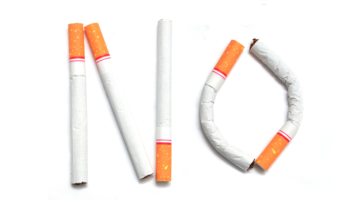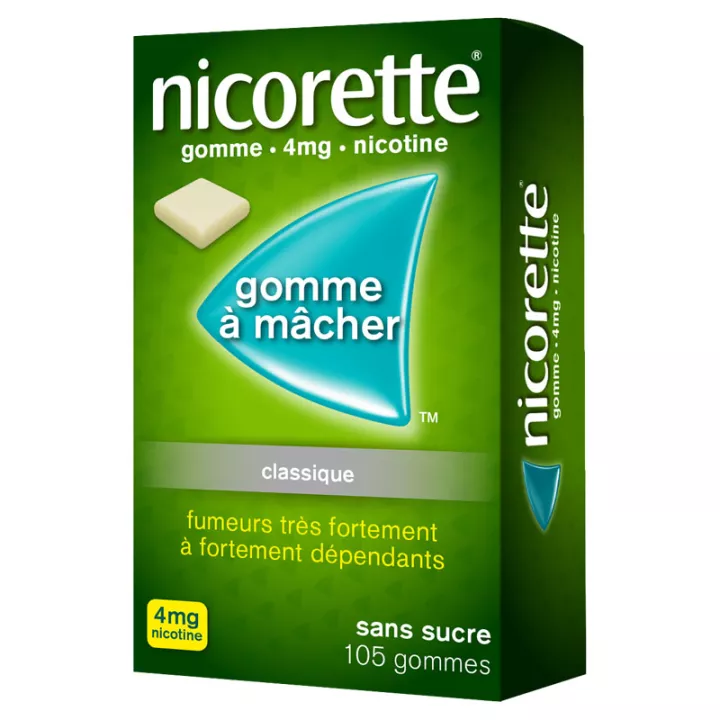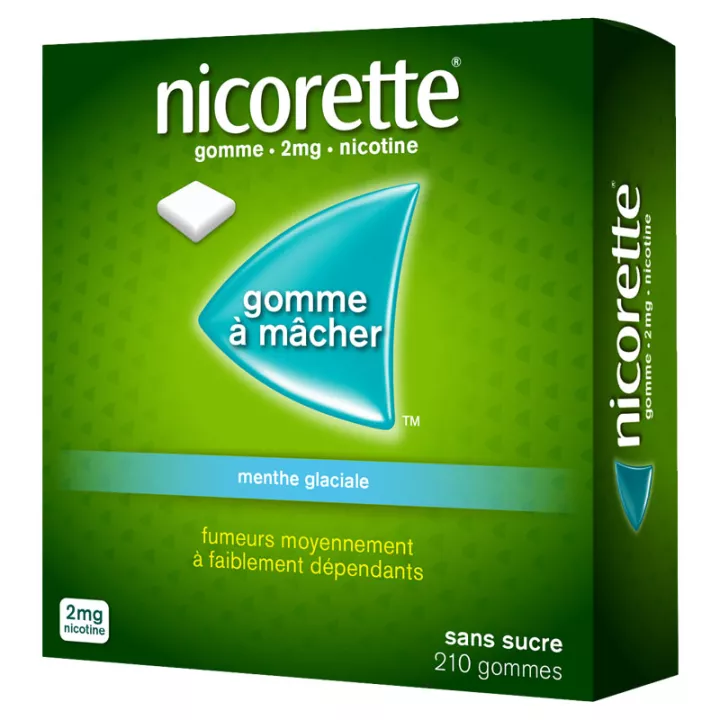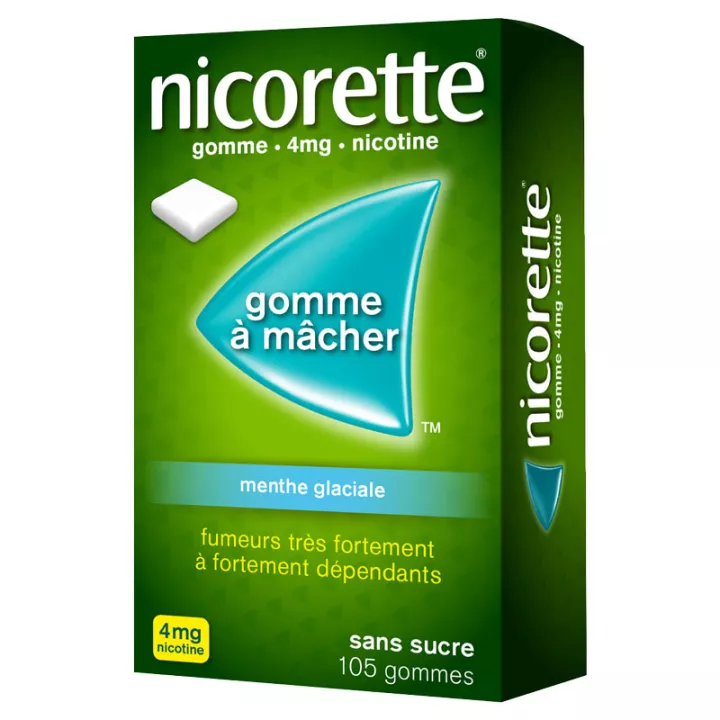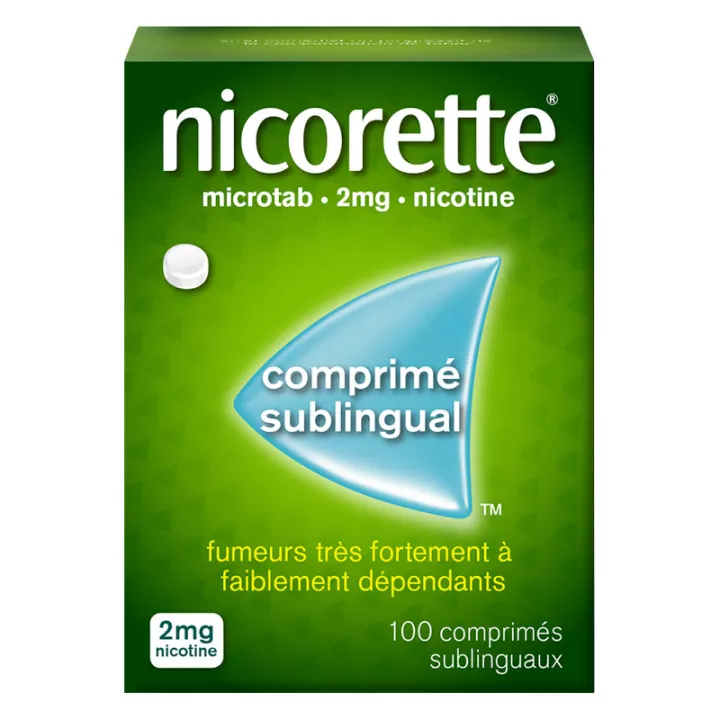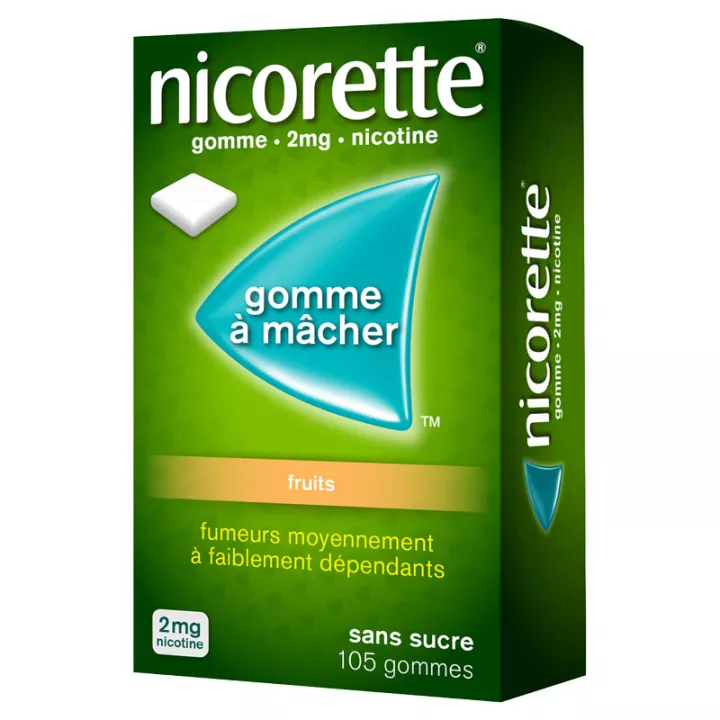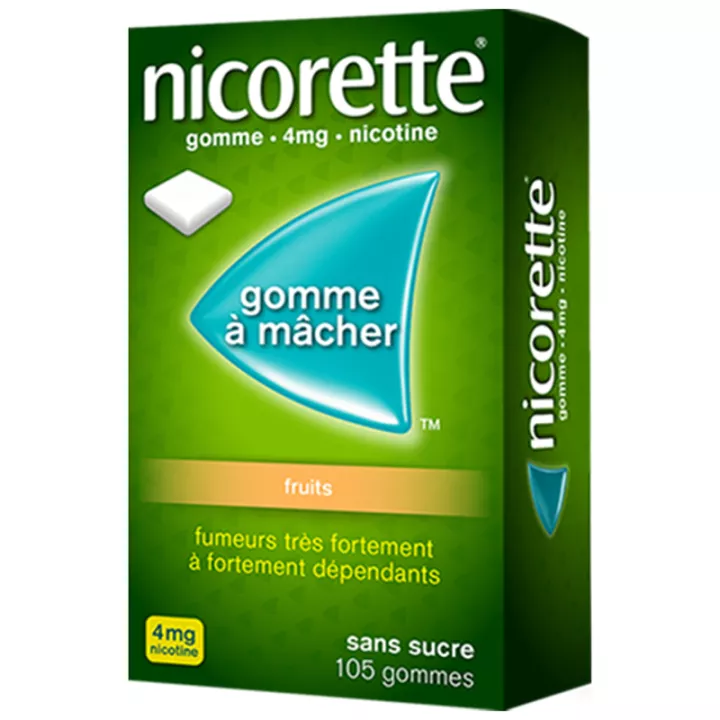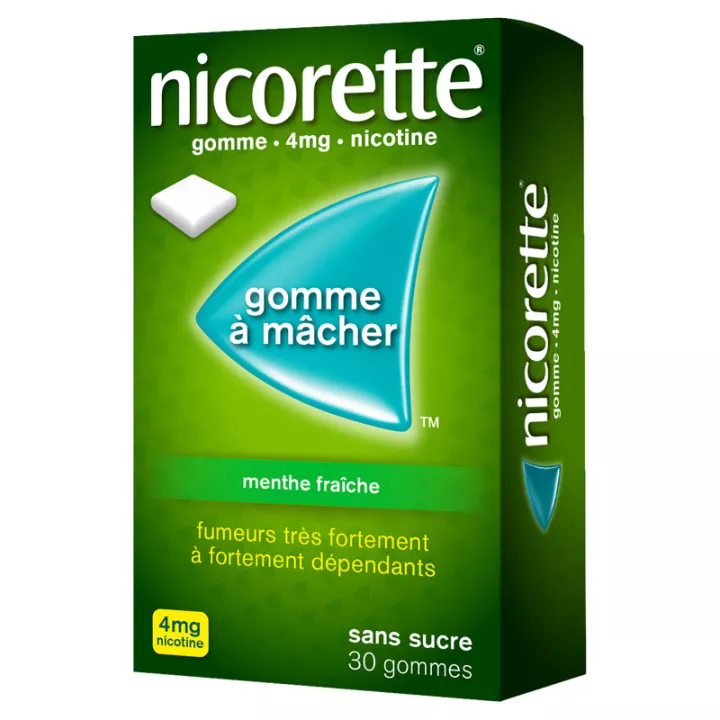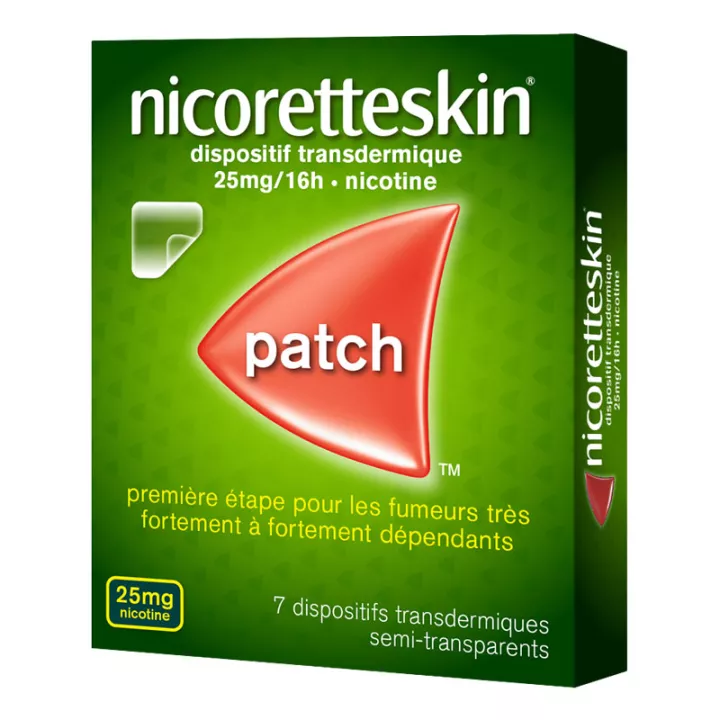NOTICE
ANSM - Last updated: 31/03/2017
Name of the medicinal product
NICORETTE 4 mg SUGAR-FREE , medicated chewing gum sweetened with sorbitol
Nicotine
framed
Please read this leaflet carefully before you start taking this medicine because it contains important information for you.
You should always use this medication exactly as prescribed in this leaflet or by your doctor or pharmacist.
· Keep this leaflet. You might need to read it again.
· Ask your pharmacist for advice or information.
· If you experience any of the side effects, talk to your doctor, or your pharmacist. This also applies to any side effects not mentioned in this leaflet. See section 4
· You should talk to your doctor if you do not feel better or feel less well.
Do not use this medication for children.
What is in this leaflet?
1. What is NICORETTE 4 mg SUGAR-FREE , sorbitol-sweetened medicated chewing gum and in which cases it is used?
2. What do you need to know before taking NICORETTE 4 mg SUGAR-FREE , sorbitol-sweetened medicated chewing gum?
3. How to take NICORETTE 4 mg SUGAR-FREE , medicated chewing gum sweetened with sorbitol?
4. What are the possible side effects?
5. How do I store NICORETTE 4 mg WITHOUT SUGAR , medicated chewing gum sweetened with sorbitol?
6. Package contents and other information.
1. WHAT NICORETTE 4 mg SUGAR-FREE, medicated chewing gum sweetened on sorbitol AND IN WHAT CASES IS IT USED?
MEDICINAL PRODUCTS USED IN NICOTINE DEPENDENCE
This drug is indicated for the treatment of tobacco dependence in order to relieve the symptoms of nicotine withdrawal in subjects wishing to stop their tobacco consumption.
Although definitive cessation of tobacco use is preferable, this drug may be used in:
· the cases where a smoker temporarily abstains from smoking,
· a strategy to reduce smoking as a step towards the final stop.
2. BEFORE YOU TAKE NICORETTE 4 mg SUGAR-FREE, medicated chewing gum sweetened on sorbitol?
If your doctor has told you about an intolerance to some sugars, contact your doctor before taking this medicine.
Do not take NICORETTE 4 mg WITHOUT SUGAR, sorbitol sweetened chewing gum:
· If you do not smoke or are an occasional smoker
· If you are allergic (hypersensitive) to nicotine or any of the other ingredients of this medication mentioned in section 6.
IN CASE OF DOUBT, IT IS ESSENTIAL TO ASK FOR THE OPINION OF YOUR DOCTOR OR YOUR PHARMACIST
Warnings and Precautions
Talk to your doctor or pharmacist before taking NICORETTE 4 mg SUGAR-FREE, medicated gum sweetened with sorbitol.
· Some diseases require examination and medical follow-up before using this medication.
Therefore, it is essential to consult your doctor before using this medication if you present:
- recent history (<3 months) of heart attack or stroke,
- chest pain (unstable angina pectoris), or stable angina pectoris,
- a heart problem affecting your heart rate or heart rate,
- an arterial hypertension that is not controlled by drugs,
- a history of allergic reactions that have manifested as swelling of the lips, face and throat (angioedema) or rash associated with itching (urticaria). It may happen that the use of a NRT triggers this type of reaction,
- severe or moderate hepatic impairment,
- severe renal insufficiency,
- diabetes,
- hyperthyroidism,
- a tumor of the adrenal gland (pheochromocytoma),
- an evolving stomach or duodenal ulcer,
- a chronic condition of the throat,
- of asthma.
· It is imperative to keep the chewing gum out of the reach of children.
Indeed, the therapeutic dose intended for the adult could cause a serious intoxication or even death in the child.
· Due to the presence of sorbitol, the use of this medicine is not recommended in patients with fructose intolerance (rare hereditary disease).
Precautions for use
· Some signs indicate an under-dosage. If you feel, despite the treatment, a feeling of "lack" such as in particular:
o compelling need to smoke,
o irritability, sleep disturbances,
o agitation or impatience,
o difficulty of concentration.
Consult your doctor or pharmacist. Indeed, it may be necessary to modify the dosage of the drug.
· Some signs may reflect an overdose: in case of signs of overdose, ie:
o nausea, abdominal pain, diarrhea,
o hypersalivation,
o sweating, headache, dizziness, hearing loss,
o general weakness.
It is imperative to adapt the treatment with the advice of your doctor or pharmacist.
IN CASE OF DOUBT DO NOT HESITATE TO REQUEST THE NOTICE OF YOUR DOCTOR OR PHARMACIST.
Children and Youth
Not applicable.
Other medicines and NICORETTE 4 m SUGAR-FREE , medicated chewing gum sorbitol sweetened
Inform your doctor if you are taking, have recently taken or may take any other medication.
This is especially important if you are taking clozapine (an antipsychotic), methadone (an opiate substitution treatment), ropinirole (a treatment for Parkinson's disease) or theophylline (used in the treatment of anti- asthma).
NICORETTE 4 mg SUGAR-FREE , medicated chewing gum sweetened with sorbitol with food and drink
Not applicable.
Pregnancy and breast feeding
If you are pregnant or breastfeeding, think you may be pregnant or plan a pregnancy, ask your doctor or pharmacist for advice before taking this medicine.
Pregnancy
It is very important to stop smoking during pregnancy as this can slow down the growth of your baby. This can also lead to premature delivery or late fetal deaths. It is advisable to stop smoking without using medicines containing nicotine.
If you are unable to stop smoking without nicotine replacement therapy, NICORETTE may be used after consulting the health care provider who is following your pregnancy, your family doctor, or a doctor at a center specializing in helping people wishing to stop smoking.
feeding
If you smoke a lot and do not plan to stop smoking, you should not breastfeed your child, but use artificial breastfeeding.
If you want to stop smoking and breastfeed your child, take advice from your doctor or a doctor at a smoking cessation center.
The use of this medication should be avoided during breast-feeding because nicotine passes into breast milk and can affect your child. If your doctor has recommended that you use NICORETTE 4 mg SUGAR-FREE, sorbitol sweetened medicated gum, the dose should be taken just after breastfeeding or more than 2 hours before the next feeding.
In addition, because of the passage of terpene derivatives (mint / eucalyptus aroma) contained in this drug and the potential neurological toxicity in the infant, you should consider a different chewing gum flavor.
Sport
Not applicable.
Driving and using machines
NICORETTE 4 mg SUGAR-FREE, medicated chewing gum sweetened with sorbitol has no effect or a negligible effect on the ability to drive and use machines.
NICORETTE 4 mg SUGAR-FREE , sorbitol-sweetened medicated chewing gum contains sorbitol (E420).
3. HOW TO TAKE NICORETTE 4 mg SUGAR-FREE, medicated chewing gum sweetened with sorbitol?
Reserved for adults (15 years and over)
Dosage
4 mg chewing gum is particularly suited for smokers who are highly or very highly dependent on nicotine (Fagerström test score of 7 to 10 or smoking more than 20 cigarettes per day: see "Health education tips" ).
Complete cessation of smoking
Treatment of nicotine dependence is usually done in 2 phases.
1 st phase
Chew a gum whenever the urge to smoke appears.
The number of chewing gum at 4 mg is generally 8 to 12 gums per day and should in no case exceed 15 gums per day.
The duration of this phase is about 3 months, but may vary depending on the individual response.
2 nd phase
When the urge to smoke is completely overcome, gradually reduce the number of chewing gums per day.
Treatment will be stopped when consumption is reduced to 1 to 2 gums per day.
It is recommended not to use chewing gum for longer than 12 months.
Temporary abstinence from tobacco
Chew a gum whenever the urge to smoke appears.
The number of chewing gum at 4 mg is generally 8 to 12 gums per day and should in no case exceed 15 gums per day.
Reduction in tobacco consumption
Where possible, alternate gums with nicotine and cigarettes.
Chew a gum as soon as the urge to smoke appears to reduce as much as possible the consumption of cigarettes and stay as long as possible without smoking.
The number of chewing gums per day varies and depends on your needs. However, it should not exceed 15 gums per day.
If a reduction in cigarette consumption has not been obtained after 6 weeks of treatment, it is recommended to seek advice from a health care professional.
Reducing tobacco consumption should gradually lead to a complete cessation of smoking. This should be attempted as soon as possible within 6 months of starting treatment. If after more than 9 months after initiating therapy, the attempt to stop smoking has failed, it is recommended to seek advice from a health professional.
It is recommended not to use gums for more than 12 months.
To increase the likelihood of complete smoking cessation, it is important to aim to reduce consumption by more than 50% during this reduction phase. NICORETTE chewing gum helps to achieve this goal before a permanent cessation of smoking.
Method and route of administration
Mouth.
To be active, the nicotine contained in the gum and released by mastication, must be absorbed by the buccal mucosa.
If nicotine is swallowed with saliva, it has no effect. It is therefore important not to chew the gum too vigorously.
For example, the chewing gum should be chewed first, then the gum should be cheeked for about 10 minutes: the gum softens and allows the nicotine to gradually release itself, to be absorbed by the buccal mucosa, thus passing through the circulation .
Then chew the gum very slowly (about 20 times in 20 minutes).
The chewing gum should be kept in the mouth for about 30 minutes. After 30 minutes, the chewing gum will no longer deliver nicotine.
Duration of treatment
For the complete cessation of tobacco:
The duration of use is limited to 12 months.
If you have persistent drowsiness or if you have difficulty with this medication, talk to your doctor.
If you take more NICORETTE 4 mg SUGAR-FREE, medicated chewing gum sweetened with sorbitol you should:
Consult your doctor or pharmacist immediately.
In case of accidental overdose or if a child swallows one or more chewing gums: CONTACT A DOCTOR OR AN EMERGENCY SERVICE.
Severe intoxication may occur and may include hypotension, weak and irregular heartbeat, respiratory discomfort, prostration, cardiovascular collapse and convulsions.
If you forget to take NICORETTE 4 mg SUGAR-FREE , medicated gum sweetened with sorbitol:
Not applicable.
If you stop taking NICORETTE 4 mg SUGAR-FREE , medicated chewing gum sweetened with sorbitol:
Not applicable.
4. WHAT ARE POSSIBLE SIDE EFFECTS?
Like all medicines, this medicine may cause side effects, although not everybody gets them.
NICORETTE may cause side effects similar to nicotine administered by other modes; these effects are mainly dose-dependent and appear at the beginning of treatment.
The gums can stick and there is in rare cases a risk of dental alteration.
The following adverse reactions have been reported:
Very common : affects more than 1 in 10 patients
· Headache
· hiccough
· Irritation of the throat
· Nausea
Common: affects 1 to 10 patients out of 100
· diarrhea
Uncommon : affects 1 to 10 patients in 1,000
· palpitations (feeling unusual to your heartbeat), or fast heartbeat (tachycardia)
· throat pain
· dreams abnormal,
· wheezing (bronchospasm) or difficult breathing (dyspnea), change in the sound of the voice
· stuffy nose, sneezing
· excessive sweating, itching / rash (pruritus / urticaria), flushing
· fatigue, discomfort, pain / discomfort in the chest
· hypertension
Rare: affects 1 to 10 patients out of 10,000
· difficulty swallowing, decreased sensitivity in the mouth
Unknown frequency : can not be estimated on the basis of available data
· blurred vision, increased tears (tearing)
· dry throat, lip pain, pain / discomfort in the abdomen
· allergic reaction including swelling of the face and mouth (angioedema) redness of the skin
Dizziness, headaches, sleep disorders, mouth ulcers may be related to smoking cessation and not to your treatment.
Due to the presence of sorbitol, possibility of digestive disorders and diarrhea.
Declaration of side effects
If you experience any side effects, talk to your doctor or pharmacist. This also applies to any side effects not mentioned in this leaflet. You can also report adverse reactions directly via the national reporting system: National Agency for the Safety of Medicines and Health Products (ANSM) and network of Regional Centers of Pharmacovigilance. Website: www.ansm.sante.fr .
By reporting adverse reactions, you are helping to provide more information about the safety of the drug.
5. HOW TO STORE NICORETTE 4 mg SUGAR-FREE, medicated chewing gum sweetened with sorbitol?
Keep this medicine out of the reach and sight of children.
Do not use this medicine after the expiry date which is stated on the package. The expiry date refers to the last day of that month.
Store at a temperature not exceeding 25 ° C.
Do not throw any medication at the sewer or with household garbage. Ask your pharmacist to remove any medications you are no longer using. These measures will help protect the environment.
6. PACKAGE CONTENTS AND OTHER INFORMATION
What NICORETTE contains 4 mg SUGAR-FREE, medicated gum sweetened with sorbitol
· The active substance is:
Catioresin nicotine carboxylate .............................................. ................................. 20.00 mg
Quantity corresponding to nicotine .............................................. ..................................... 4.00 mg
For a chewing gum.
· The other components are: Anhydrous sodium carbonate, Dreyco gum, sorbitol (E420), 70% sorbitol crystallizable, Haverstroo flavor, smoker flavor, 85% glycerol, quinoline yellow.
Composition of gum Dreyco: Copolymers of isobutylene and isoprene, petroleum wax, polyvinyl acetate, polyethylene polyisobutylene, glycerol esters of rosin and polymerized rosin, hydrogenated vegetable oils, glycerol monostearate, calcium carbonate, butylhydroxytoluene.
Composition of the aroma Haverstroo: Menthol, essential oil of peppermint, essential oil of mint frizzy, essential oil of eucalyptus.
Composition of the smoking flavor: Vanillin, geranyl propionate, ethyl butyrate, amyl butyrate, ethyl alcohol, ethyl pelargonate, eugenol, cinnamate cinnamyl, amyl acetate, orange essential oil, wrinkled mint, ethyl acetate, ethyl oenanthate.
What is NICORETTE 4 mg SUGAR-FREE, medicated chewing gum sweetened with sorbitol and contents of the pack
This medication is in the form of chewing gum. Box of 12, 15, 30, 36, 45, 96 or 105 chewing gums.
Not all pack sizes may be marketed.
Marketing Authorization Holder
JOHNSON & JOHNSON SANTE BEAUTE FRANCE
1, RUE CAMILLE DESMOULINS
92130 ISSY-LES-MOULINEAUX
Marketing Authorization Operator
JOHNSON & JOHNSON SANTE BEAUTE FRANCE
1, RUE CAMILLE DESMOULINS
92130 ISSY-LES-MOULINEAUX
Maker
MCNEIL AB
NORRBROPLATSEN 2
251 09 HELSINGBORG
SWEDEN
Names of the medicinal product in the Member States of the European Economic Area
Not applicable.
The last date on which this leaflet was revised is:
[to be completed later by the holder]
{MM / YYYY} {YYYY months}.
Other
Health Education Council:
Stopping smoking as soon as possible results in immediate health benefits. It's never too late to quit even if you've smoked a long time and a lot.
As soon as you stop smoking:
· You will not absorb the irritating and toxic substances of cigarettes,
· You will see some improvements: progressive disappearance of headaches, cough, irritation of the throat, shortness of breath,
· You will often have the satisfaction of regaining better sleep, food flavor, odor and improve your physical performance,
· You will reduce your risk of developing lung cancer or cardiovascular disease.
Moreover, in cardiac or arterial diseases (angina pectoris, arteritis of the lower limbs ...), it is particularly imperative to succeed in quitting smoking.
What is tobacco dependence?
Tobacco addiction is twofold:
· Psychological dependence :
Smoking a cigarette involves a ritual of automatic and repetitive gestures associated with particular circumstances (pleasure, response to stress, intellectual stimulation, support for morale, need for a gesture of conviviality). This is psychological and behavioral dependence.
· Physical dependence :
The need for the nicotine body is due to the effects of this substance on the nervous system. This is physical dependence. Failure to satisfy this need results in a sense of lack (see description in the chapter " How to overcome your physical dependence ?").
Nicotinic substitutes aim to treat this dependence.
How to overcome your psychological addiction?
· Stopping smoking is necessary to increase your chances of success, but more:
o Choose a J day in the period that you think is the most favorable.
o Throw away your last pack of cigarettes, your lighter and put away your ashtrays.
o In a couple of smokers, it is preferable that the attempt to stop is made at the same time by both spouses.
· Tell your family and co-workers that you quit smoking. Ask them to respect your decision (no smoking near you, no longer offering you cigarettes).
· Prepare yourself to cope with the desire to smoke. It may occur suddenly and severely, especially during the first few weeks after the cessation of smoking, but does not last more than 3 or 4 minutes. You must anticipate what you will do in this case and act very quickly so as not to "crack" as for example:
o drink a large glass of water,
o to chew gum,
o counting up to 100,
o do some deep breaths,
o out of the room,
o change activity ...
· Avoid situations associated with taking cigarettes (coffee, aperitif, ...), avoid temptations (settle with non-smokers).
· Find cigarette compensation (leisure, sport, cultural activity ...).
How to overcome your physical addiction?
If you are addicted to nicotine, the success of your approach may require the use of nicotine substitutes.
In order to assess your level of dependence, the Fagerström test is offered.
FAGERSTROM TEST
How long after you wake up do you smoke your first cigarette? | |
· within 5 minutes: 3 | |
· from 6 to 30 minutes: 2 | |
· from 31 to 60 minutes: 1 | |
· after 60 minutes: 0 | |
Do you find it difficult to not smoke in places where it is forbidden? | |
· yes: 1 | |
· no: 0 | |
What cigarette of the day would you be the hardest to give up? | |
· the first: 1 | |
· another: 0 | |
How many cigarettes do you smoke per day? | |
· 10 or less: 0 | |
· 11 to 20: 1 | |
· 21 to 30: 2 | |
· 31 or more: 3 | |
Do you smoke at a more sustained pace in the morning than in the afternoon? | |
· yes: 1 | |
· no: 0 | |
Do you smoke when you are so sick that you have to stay in bed almost all day? | |
· yes: 1 | |
· no: 0 | |
TOTAL POINTS | |
score 0 to 2 : you are not addicted to nicotine.
You can stop smoking without the need for nicotine replacement.
If you are concerned about this decision, consult your pharmacist or doctor.
score 3 to 4 : you are weakly dependent on nicotine.
score 5 to 6 : you are moderately addicted to nicotine.
The use of nicotine substitutes will increase your chances of success.
Consult with your pharmacist or doctor to help you choose the treatment best suited to your situation.
score 7 to 10 : you are strongly or very strongly dependent on nicotine.
The use of nicotine substitutes is recommended to help you overcome this addiction to nicotine. This treatment should be used in sufficient and appropriate dosage.
Consult with your pharmacist or doctor, possibly as part of a specialized smoking cessation counseling.
Weaning-related disorders may persist for a long time and the duration of treatment should be sufficient, usually one to three months.
If you feel, despite the treatment, a feeling of persistent "lack" such as:
· compelling need to smoke,
· irritability, sleep disturbances,
· agitation or impatience,
· difficulty of concentration,
Take the advice of your doctor or pharmacist as doses may need to be adjusted.
How do you get help?
· Support from health professionals
The support, advice and follow-up that your doctor or pharmacist can give you will be valuable during the first six months of your smoking cessation. You can also use a specialized smoking cessation counseling, especially if you have already failed.
· Psychological support
Stopping smoking requires a supportive family and social environment. If you are concerned that the difficulties are too great, psychological support or temporary treatment can help.
· Dietetics
In the months following tobacco cessation, you may find moderate weight gain. If you have any concerns in this area, you can contact a health professional who will be able to advise you.
You started smoking again, why?
Consider this relapse as an accident of course, as a normal event that allows to learn: the relapse is not a failure.
Analyze the reasons why you took back the tobacco.
· Because of the physical dependence
This may have been poorly taken into account or reappeared after several months, occasionally, for example, by prolonged stays in smoky atmospheres.
· Because of excessive weight gain
It may be necessary to change your diet somewhat before your next attempt to quit smoking.
· Because of a decline in motivation , because of a painful event or a difficult period, because of psychological difficulties appearing at the cessation of smoking (depression, anxiety ...), because of a situation very tempting. Understand the reason for this relapse to prevent it if possible during the next attempt.
In all cases, do not hesitate to ask for advice from a health professional or to use a specialized consultation to help with smoking cessation.
If you have started smoking again, do not get discouraged, experience shows that your chances of success increase after one or more attempts to quit.
